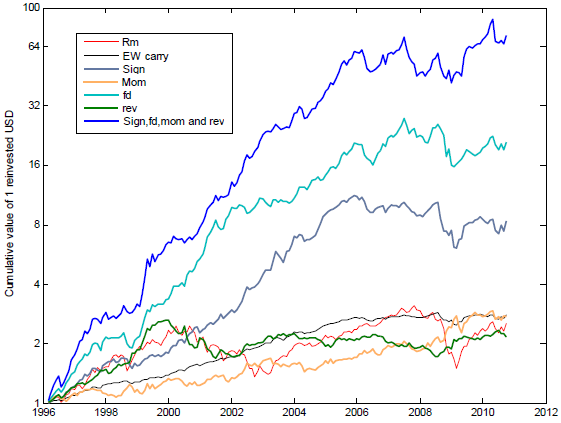How attractive can currency trading be after optimizing across several anomalies? In the November 2011 version of their paper entitled “Beyond the Carry Trade: Optimal Currency Portfolios”, Pedro Barroso and Pedro Santa-Clara examine the performance of utility-maximized currency strategies designed to exploit interest rate variables, momentum, long-term reversal, current account and real exchange rate during the floating exchange rate era. They also investigate whether such currency strategies are valuable to investors holding portfolios of equities and bonds. Their benchmark portfolio consists of $1 invested in the U.S. risk-free rate and $1 risked in a hedged carry trade (long all currencies yielding more than the U.S. dollar and short all others, with long and short sides equal and equal weighting across currencies within each side). They assume a power law utility function with constant level of risk aversion to specify optimal currency weightings. They perform out-of-sample testing based on inception-to-date regressions executed annually to specify optimal portfolios for the next year, commencing 240 months into the sample. Using spot and one-month forward exchange rates and data on current accounts and inflation as available for 27 developed economies during November 1960 through September 2010 (a total of 7,197 monthly currency returns involving 13 to 21 currencies per year), they find that:
- Over the sample period, the benchmark carry trade portfolio generates a gross annual Sharpe ratio of 0.91, more than double that of the U.S. stock market (0.41).
- During the February 1996 to September 2010 out-of-sample test period, the currency portfolio optimally exploiting all identified predictive variables generates a gross annual Sharpe ratio of 1.40, easily beating the benchmark carry trade. When leveraged to the annual standard deviation of the U.S. stock market, this strategy:
- Produces an average gross annual return that beats that of U.S. stock market by 16%.
- Increases the gross value of a $1 initial investment to $72.87, compared to $2.53 for a $1 initial investment in the U.S. stock market (see the chart below).
- Contributions of the predictive variables to beating the benchmark carry trade rank as follows:
- The interest rate spread contributes most.
- Imposition of utility-maximization has a strong positive effect on performance.
- The momentum contribution is also important, partly through reducing exposure to carry trade positions when high-yielding currencies generate low returns.
- Long-term reversal consistently contributes.
- Currency fundamentals (current account and real exchange rate) are essentially irrelevant.
- During the out-of-sample test period, adding the optimal currency strategy to a portfolio of stocks and bonds boosts gross annual Sharpe ratio from 0.39 to 1.47, substantially suppressing the left tail of the return distribution. In other words, currency portfolio returns are largely independent of those of other asset classes.
- After incorporating a conservative round trip trading friction of 0.1% over the out-of-sample test period:
- The optimal currency portfolio outperforms the benchmark carry trade by an average 8.7% per year, still substantially boosting Sharpe ratio and suppressing crash risk for a stocks-bonds portfolio.
- While the optimal currency portfolio strategy is more closely related to equity risk factors than to the benchmark carry trade, it still beats the U.S. stock market by an average 13.9% per year, remaining mostly positive during the recent financial crisis. A $1 initial investment grows to as much as $11.75 net.
The following chart, taken from the paper, tracks gross cumulative values of $1 initial investments in the following seven benchmark/currency allocation strategies on a logarithmic scale during the February 1996 through September 2010 out-of-sample test period:
- As a widely used benchmark, the broad U.S. stock market (Rm).
- The benchmark equally weighted carry trade (EW carry).
- A carry trade with long and short currency weightings determined by utility maximization (Sign).
- Currency weightings determined by normalized currency returns during the last three months (Mom).
- Currency weightings determined by the forward interest rate spread (discount), measured in standard deviations above or below the mean for all currencies (fd).
- Currency weightings determined by normalized inverse real currency returns over the previous five years, excluding the most recent three months (rev).
- A combination of Sign, fd, Mom and rev strategies.
Results indicate that exploitation of the interest rate spread (fd) and imposition of utility maximization (Sign) substantially outperform other individual strategies. However, absolute returns of most currency strategies fade or disappear since the end of 2005.

In summary, evidence from fairly complex modeling indicates that applying utility maximization and predictive variables to currency trading generates attractive absolute returns with substantial diversification benefits relative to stocks and bonds. However, these returns fade or disappear in recent years.
Cautions regarding findings include:
- Data collection/calculations and capital requirements/management for the utility-optimized currency portfolio may be problematically complex for many investors (or costly if delegated to a manager).
- Data snooping bias can be present in “out-of-sample” backtesting when strategy/parameter selection derives from combinations known to work from other studies of the backtest period.